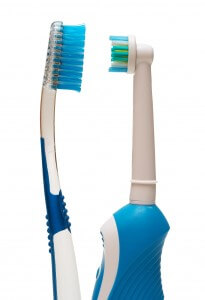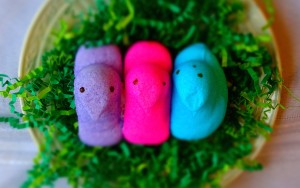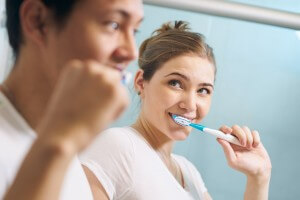
Did you know? The earliest recorded use of toothbrushes occurred in China in the 7th Century, A.D. They utilized bamboo for handles, and bristles made from hog’s hair specially sourced from Siberia for its coarser, stiffer texture. Eww…
Toothbrushes have come a long way since then. Some of today’s modern innovations include prototype models that use mild electrical charges to dislodge plaque from teeth. With numerous traditional and electric toothbrush products available, as well as brush stiffness options, consumers face a lot of choices. We’ll help you break them down:
Manual
The most obvious benefit of traditional models is simplicity – pick it up, apply toothpaste and go. Additionally, manual toothbrushes are relatively inexpensive (or even free with checkups at Meyer & Johns Dental!) The main drawback of manuals is human error, with the most common mistakes being inconsistent cleaning of all tooth surfaces, and using too much/too little pressure.
Electric
There are many benefits to electric toothbrushes. Both oscillating (rotating head) and sonic (vibrating head) models offer superior cleaning, removing an average of 21 percent more plaque than traditional brushes, according to Consumer Reports. Electrics were also recommended for arthritis sufferers or others with dexterity issues that prevent effective manual brushing. Additionally, use of an electric model was shown to reduce gingivitis by 11 percent, likely due to the more consistent brush-on-tooth pressure that they allow.
Cost is the primary drawback to electrics. In addition to the base unit, users must purchase more-expensive replacement brush heads, which must be changed roughly as often as traditional brushes. Additionally, they must remain charged, and the corded bases are less compact, which may be cumbersome for frequent travelers.
For Kids
Children’s electrics offer the best of both worlds. Besides delivering enhanced plaque removal, nearly all models include an automatic timer. This supports development of good brushing habits by notifying the child when they’ve finished the recommended two-minute brushing time.
Consumer Reports dental adviser Jay W. Friedman, D.D.S. noted that – regardless of toothbrush model – the important thing is to keep brushing. But he also warned against over-brushing, which can degrade enamel and cause gums to recede.
Whatever your choice, Meyer & Johns Dental wants you to BRUSH! Ask us the next time you schedule your regular check-up, and we’ll help you choose the brushes that are best for your family’s unique needs.

